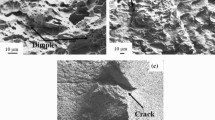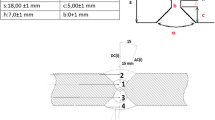This work presents the Charpy energy values (CVN) in the ductile-to-brittle transition (DBT) temperature zone for different directions with respect to the longitudinal direction of API 5L X52 seamless pipeline steel. The material-processing directions were L-T, T-L, S-T, T-S, L-S, S-L, and 45°. At the same time, the temperature variation was –100, 0, 25, 50, and 100°C. Charpy impact specimens were machined in accordance with the ASTM E23 standard, with dimensions of 10×10×55 mm. In addition, the microstructures and fracture surfaces were examined using scanning electron microscopy. The energy values for all directions show lower shelf behavior at –100°C, a transition zone from –100 to 50°C, and an upper shelf behavior above 50°C as the characteristics of this type of grade pipeline.






Similar content being viewed by others
Abbreviations
- DBTT:
-
Ductile-to-brittle transition temperature
- CVN:
-
Charpy V-notch
- SEM:
-
Scanning electron microscopy
- SMLSS:
-
Seamless pipeline
- TIG:
-
Tungsten inert gas
References
Q. Wu, Z. Zhang, Y. Liu, H. Chen, “Strain aging behavior of Cu-containing microalloyed low carbon seamless pipeline steel,” Mater Sci Technol, 33, No. 1, 72–76 (2017). https://doi.org/10.1080/02670836.2016.1160526
R. R. Winston, Oil and Gas Pipeline, Integrity and Safety Handbook, Wiley (2015).
D.-H. Seo, J.-Y. Yoo, W.-H. Song, and K.-B. Kang, “Development of X100 linepipe steel with high deformation capacity,” in: Proceeding of IPC2008 (7th International Pipeline Conference, September, Calgary, Alberta, Canada) (2008). https://doi.org/10.1115/IPC2008-64220
S. Y. Shin, B. Hwang, S. Lee, et al., “Correlation of microstructure and Charpy impact properties in API X70 and X80 line-pipe steels,” Mat Sci Eng A-Struct, 458, Nos. 1-2, 281–289 (2007). https://doi.org/10.1016/j.msea.2006.12.097
G. Terán, S. Capula-Colindres, D. Angeles-Herrera, et al., “Estimation of fracture toughness KIC from Charpy impact test data in T-welded connections repaired by grinding and wet welding,” Eng Fract Mech, 153, 351–359 (2016). https://doi.org/10.1016/j.engfracmech.2015.12.010
S. Capula-Colindres, G. Terán, D. Angeles-Herrera, et al., “Determination of fracture toughness and KICCVN correlations for BM, HAZ, and WB in API 5L X60 pipeline,” Arab J Sci Eng, 46, No. 7461–7469 (2021). https://doi.org/10.1007/s13369-021-05451-8
J. Hu, Y. Liu, G. Wang, and Q. Li, “Study on nonuniform microstructure and strength-toughness mechanism of thick-walled hot induction seamless bend,” Mater Res Express, 8, No. 10, 106505 (2121). https://doi.org/10.1088/2053-1591/ac27cf
K. Biermann, C. Kaucke, M. Probst-Hein, and B. Koschlig, “Alloying concept for high-strength seamless heavy-wall line pipe suitable for sour service applications,” in: Proc. of the International Pipeline Conference, Calgary, Alberta, Canada, IPC2004-0488 (2004). https://doi.org/10.1115/IPC2004-0488
L. Zhongqiu, F. Jian, Z. Young, and Y. Zexi, “Influence of quenching on-line on properties of X70 steel for sour services seamless pipe,” Energy Procedia, 16, 444–450 (2012). https://doi.org/10.1016/j.egypro.2012.01.072
A. Amirat, K. Chaqui. Z. Azari, and G. Pluvinage, "Residual stress analysis in seamless API X60 steel gas pipeline," Sci Technol, 21, 7–14 (2004).
M. Paredes, J. Lian, T. Wierbicki, et al., “Modeling of plasticity and fracture behavior of X65 steel: seam weld and seamless pipes,” Int J Fracture, 213, 17–36 (2018). https://doi.org/10.1007/s10704-018-0303-x
L. Barbosa Godefroid, B. Mendes Sena, and V. Braz da Trindade Filho, “Evaluation of microstructure and mechanical properties of seamless steel pipes API 5L type obtained by different processes of heat treatments,” Mater Res, 20, No. 2, 514–522 (2017). https://doi.org/10.1590/1980-5373-MR-2016-0545
ASTM E23, Standard Test Methods for Notched Impact Testing of Metallic Materials (2018).
ANSI/API 5L Specification for Line Pipe, 44th Edition (2010).
C. Zong, G. Zhu, and W. Mao, “Effect of crystallographic texture on the anisotropy of Charpy impact behavior in pipeline steel,” Mater Sci Eng A, 563, 1–7 (2013). https://doi.org/10.1016/j.msea.2012.11.055
W. Wang, Y. Shan, and K. Yang, “Study of strength pipeline steels with different microstructures,” Mater Sci Eng A, 502, 38–44 (2009). https://doi.org/10.1016/j.msea.2008.10.042
ASTM E1268, Standard Practice for Assessing the Degree of Banding or Orientation of Microstructures (2019).
M. W. Braestrup, J. B. Andersen, L. W. Andersen, et al., Design and Installation of Marine Pipelines, Blackwell Science Ltd. (2005).
D. Toma, V. Rohden, and G. Kubia, “Development of API X-70-80 grades heavy-wall seamless pipe with low temperature toughness,” in: Offshore Technology Conference Rio de Janeiro, Brazil (2011). https://onepetro.org/OTCBRASIL/proceedings-abstract/11OBRA/All-11OBRA/OTC-22538-MS/36986
E. Anelli, D. Colleuori, J. C. Gonzalez, et al., “Sour service X65 seamless linepipe for offshore special applications,” in: The Eleventh International Offshore and Polar Engineering Conference, Stavanger, Norway (2001). https://onepetro.org/ISOPEIOPEC/proceedings-abstract/ISOPE01/All-ISOPE01/ISOPE-I-01-377/8118
G. Terán, S. Capula-Colindres, F. Chávez, et al., “Charpy impact toughness in all directions with respect to the rolling direction of API 5L X52 pipeline steel,” MRS Advances, 7, 1022–1027 (2022). https://doi.org/10.1557/s43580-022-00371-7
X. J. Shen, S. Tang, Y. J. Wu, et al., “Evolution of microstructure and crystallographic texture of microalloyed steel during warm rolling in dual phase region and their influence on mechanical properties,” Mater Sci Eng A, 685, 194–204 (2017). https://doi.org/10.1016/j.msea.2016.12.108
D. H. Angeles, A. Albiter, R. M. Cuamatzi, and A. J. R. Ramirez, “Influence of non-metallic inclusion on the fracture toughness properties on the longitudinal welding of an API 5L steel pipeline,” J Test Eval, 45, 687–694 (2017). https://doi.org/10.1520/JTE20150061
D. Angeles, A. Albiter, R. Cuamatzi, et al., “Fracture-toughness and fatigue crack growth evaluation in the transversal direction of the longitudinal weld of an API X52 steel pipeline,” J Test Eval, 46, 2110–2120 (2018). https://doi.org/10.1520/JTE20170068
H. Tervo, A. Kaijalainen, T. Pikkarainen, et al., “Effect of impurity level and inclusions on the ductility and toughness of an ultra-high-strength steel,” Mater Sci Eng A, 697, 184–193 (2017). https://doi.org/10.1016/j.msea.2017.05.013
T. P. Chang, B. K. Suk, H. S. Hee, and Y. Y. Koo, “A new fracture analysis technique for Charpy impact test using image processing,” Korean J Met Mater, 59, 61–66 (2021).
C. Zong, G. Zhu, and W. Mao, “Effect of crystallographic texture on the anisotropy of Charpy impact behavior in pipeline steel,” Mater Sci Eng A, 563, 1–7 (2013). https://doi.org/10.1016/j.msea.2012.11.055
M. P. Manahan, C. N. McCowan, and M. P. Manahan, “Percent shear area determination in Charpy impact testing,” J ASTM Int, 5, No. 7, 1–15 (2008). https://doi.org/10.1520/JAI101662
P. Fassina, F. Bolzoni, G. Fumagalli, et al., “Influence of hydrogen and low temperature on mechanical behavior of two pipeline steels,” Eng Fract Mech, 81, 43–45 (2012). https://doi.org/10.1016/j.engfracmech.2011.09.016
A. Waqas, X. Qin, J. Xiong, et al., “Analysis of ductile fracture obtained by Charpy impact test of a steel structure created by robot-assisted GMAW-based additive manufacturing,” Metals, 9, 1–12 (2019). https://doi.org/10.3390/met9111208
Author information
Authors and Affiliations
Corresponding author
Additional information
Translated from Problemy Mitsnosti, No. 1, p. 129, January – February, 2024.
Rights and permissions
Springer Nature or its licensor (e.g. a society or other partner) holds exclusive rights to this article under a publishing agreement with the author(s) or other rightsholder(s); author self-archiving of the accepted manuscript version of this article is solely governed by the terms of such publishing agreement and applicable law.
About this article
Cite this article
Capula-Colindres, S., Terán, G., Velázquez, J.C. et al. Charpy Impact Toughness and Transition Temperature for API 5L X52 Seamless Pipeline. Strength Mater (2024). https://doi.org/10.1007/s11223-024-00635-7
Received:
Published:
DOI: https://doi.org/10.1007/s11223-024-00635-7




